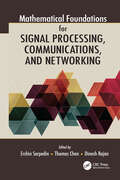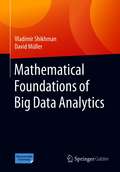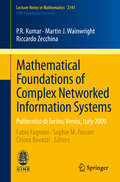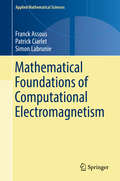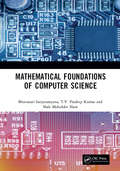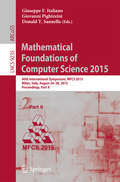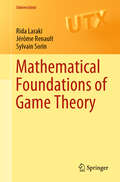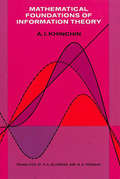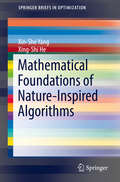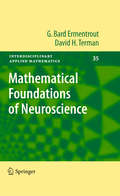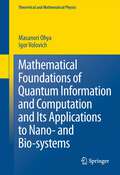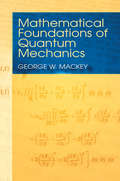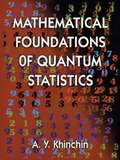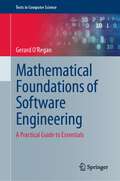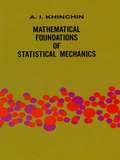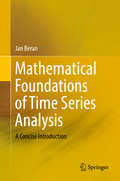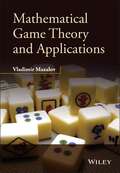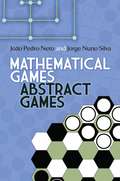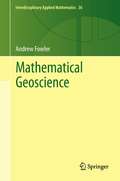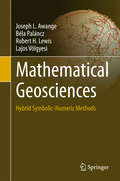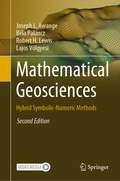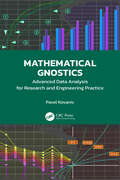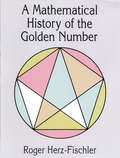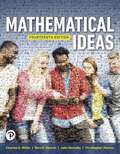- Table View
- List View
Mathematical Foundations for Signal Processing, Communications, and Networking
by Erchin Serpedin, Thomas Chen and Dinesh RajanMathematical Foundations for Signal Processing, Communications, and Networking describes mathematical concepts and results important in the design, analysis, and optimization of signal processing algorithms, modern communication systems, and networks. Helping readers master key techniques and comprehend the current research literature, the book offers a comprehensive overview of methods and applications from linear algebra, numerical analysis, statistics, probability, stochastic processes, and optimization. From basic transforms to Monte Carlo simulation to linear programming, the text covers a broad range of mathematical techniques essential to understanding the concepts and results in signal processing, telecommunications, and networking. Along with discussing mathematical theory, each self-contained chapter presents examples that illustrate the use of various mathematical concepts to solve different applications. Each chapter also includes a set of homework exercises and readings for additional study. This text helps readers understand fundamental and advanced results as well as recent research trends in the interrelated fields of signal processing, telecommunications, and networking. It provides all the necessary mathematical background to prepare students for more advanced courses and train specialists working in these areas.
Mathematical Foundations of Big Data Analytics
by Vladimir Shikhman David MüllerIn this textbook, basic mathematical models used in Big Data Analytics are presented and application-oriented references to relevant practical issues are made. Necessary mathematical tools are examined and applied to current problems of data analysis, such as brand loyalty, portfolio selection, credit investigation, quality control, product clustering, asset pricing etc. – mainly in an economic context. In addition, we discuss interdisciplinary applications to biology, linguistics, sociology, electrical engineering, computer science and artificial intelligence. For the models, we make use of a wide range of mathematics – from basic disciplines of numerical linear algebra, statistics and optimization to more specialized game, graph and even complexity theories. By doing so, we cover all relevant techniques commonly used in Big Data Analytics.Each chapter starts with a concrete practical problem whose primary aim is to motivate the study of a particular Big Data Analytics technique. Next, mathematical results follow – including important definitions, auxiliary statements and conclusions arising. Case-studies help to deepen the acquired knowledge by applying it in an interdisciplinary context. Exercises serve to improve understanding of the underlying theory. Complete solutions for exercises can be consulted by the interested reader at the end of the textbook; for some which have to be solved numerically, we provide descriptions of algorithms in Python code as supplementary material.This textbook has been recommended and developed for university courses in Germany, Austria and Switzerland.
Mathematical Foundations of Complex Networked Information Systems
by P. R. Kumar Martin J. Wainwright Riccardo Zecchinafabio Fagnani Sophie M. Fosson Chiara RavazziIntroducing the reader to the mathematics beyond complex networked systems, these lecture notes investigate graph theory, graphical models, and methods from statistical physics. Complex networked systems play a fundamental role in our society, both in everyday life and in scientific research, with applications ranging from physics and biology to economics and finance. The book is self-contained, and requires only an undergraduate mathematical background.
Mathematical Foundations of Computational Electromagnetism (Applied Mathematical Sciences #198)
by Franck Assous Patrick Ciarlet Simon LabrunieThis book presents an in-depth treatment of various mathematical aspects of electromagnetism and Maxwell's equations: from modeling issues to well-posedness results and the coupled models of plasma physics (Vlasov-Maxwell and Vlasov-Poisson systems) and magnetohydrodynamics (MHD). These equations and boundary conditions are discussed, including a brief review of absorbing boundary conditions. The focus then moves to well‐posedness results. The relevant function spaces are introduced, with an emphasis on boundary and topological conditions. General variational frameworks are defined for static and quasi-static problems, time-harmonic problems (including fixed frequency or Helmholtz-like problems and unknown frequency or eigenvalue problems), and time-dependent problems, with or without constraints. They are then applied to prove the well-posedness of Maxwell’s equations and their simplified models, in the various settings described above. The book is completed with a discussion of dimensionally reduced models in prismatic and axisymmetric geometries, and a survey of existence and uniqueness results for the Vlasov-Poisson, Vlasov-Maxwell and MHD equations. The book addresses mainly researchers in applied mathematics who work on Maxwell’s equations. However, it can be used for master or doctorate-level courses on mathematical electromagnetism as it requires only a bachelor-level knowledge of analysis.
Mathematical Foundations of Computer Science
by Bhavanari Satyanarayana T.V. Pradeep Kumar Shak Mohiddin ShawPlease note: Taylor & Francis does not sell or distribute the Hardback in India, Pakistan, Nepal, Bhutan, Bangladesh and Sri Lanka
Mathematical Foundations of Computer Science 2015
by Donald T. Sannella Giovanni Pighizzini Giuseppe F ItalianoThis two volume set LNCS 9234 and 9235 constitutes the refereed conference proceedings of the 40th International Symposium on Mathematical Foundations of Computer Science, MFCS 2015, held in Milan, Italy, in August 2015. The 82 revised full papers presented together with 5 invited talks were carefully selected from 201 submissions. The papers feature high-quality research in all branches of theoretical computer science. They have been organized in the following topical main sections: logic, semantics, automata, and theory of programming (volume 1) and algorithms, complexity, and games (volume 2).
Mathematical Foundations of Game Theory (Universitext)
by Rida Laraki Jérôme Renault Sylvain SorinThis book gives a concise presentation of the mathematical foundations of Game Theory, with an emphasis on strategic analysis linked to information and dynamics. It is largely self-contained, with all of the key tools and concepts defined in the text.Combining the basics of Game Theory, such as value existence theorems in zero-sum games and equilibrium existence theorems for non-zero-sum games, with a selection of important and more recent topics such as the equilibrium manifold and learning dynamics, the book quickly takes the reader close to the state of the art. Applications to economics, biology, and learning are included, and the exercises, which often contain noteworthy results, provide an important complement to the text.Based on lectures given in Paris over several years, this textbook will be useful for rigorous, up-to-date courses on the subject. Apart from an interest in strategic thinking and a taste for mathematical formalism, the only prerequisite for reading the book is a solid knowledge of mathematics at the undergraduate level, including basic analysis, linear algebra, and probability.
Mathematical Foundations of Infinite-Dimensional Statistical Models
by Evarist Giné Richard NicklIn nonparametric and high-dimensional statistical models, the classical Gauss-Fisher-Le Cam theory of the optimality of maximum likelihood estimators and Bayesian posterior inference does not apply, and new foundations and ideas have been developed in the past several decades. This book gives a coherent account of the statistical theory in infinite-dimensional parameter spaces. The mathematical foundations include self-contained 'mini-courses' on the theory of Gaussian and empirical processes, on approximation and wavelet theory, and on the basic theory of function spaces. The theory of statistical inference in such models - hypothesis testing, estimation and confidence sets - is then presented within the minimax paradigm of decision theory. This includes the basic theory of convolution kernel and projection estimation, but also Bayesian nonparametrics and nonparametric maximum likelihood estimation. In the final chapter, the theory of adaptive inference in nonparametric models is developed, including Lepski's method, wavelet thresholding, and adaptive inference for self-similar functions.
Mathematical Foundations of Information Theory (Dover Books on Mathematics)
by A. Ya. KhinchinThe first comprehensive introduction to information theory, this book places the work begun by Shannon and continued by McMillan, Feinstein, and Khinchin on a rigorous mathematical basis. For the first time, mathematicians, statisticians, physicists, cyberneticists, and communications engineers are offered a lucid, comprehensive introduction to this rapidly growing field.In his first paper, Dr. Khinchin develops the concept of entropy in probability theory as a measure of uncertainty of a finite “scheme,” and discusses a simple application to coding theory. The second paper investigates the restrictions previously placed on the study of sources, channels, and codes and attempts “to give a complete, detailed proof of both … Shannon theorems, assuming any ergodic source and any stationary channel with a finite memory.”Partial Contents: I. The Entropy Concept in Probability Theory — Entropy of Finite Schemes. The Uniqueness Theorem. Entropy of Markov chains. Application to Coding Theory. II. On the Fundamental Theorems of Information Theory — Two generalizations of Shannon’s inequality. Three inequalities of Feinstein. Concept of a source. Stationarity. Entropy. Ergodic sources. The E property. The martingale concept. Noise. Anticipation and memory. Connection of the channel to the source. Feinstein’s Fundamental Lemma. Coding. The first Shannon theorem. The second Shannon theorem.
Mathematical Foundations of Nature-Inspired Algorithms (SpringerBriefs in Optimization)
by Xin-She Yang Xing-Shi HeThis book presents a systematic approach to analyze nature-inspired algorithms. Beginning with an introduction to optimization methods and algorithms, this book moves on to provide a unified framework of mathematical analysis for convergence and stability. Specific nature-inspired algorithms include: swarm intelligence, ant colony optimization, particle swarm optimization, bee-inspired algorithms, bat algorithm, firefly algorithm, and cuckoo search. Algorithms are analyzed from a wide spectrum of theories and frameworks to offer insight to the main characteristics of algorithms and understand how and why they work for solving optimization problems. In-depth mathematical analyses are carried out for different perspectives, including complexity theory, fixed point theory, dynamical systems, self-organization, Bayesian framework, Markov chain framework, filter theory, statistical learning, and statistical measures. Students and researchers in optimization, operations research, artificial intelligence, data mining, machine learning, computer science, and management sciences will see the pros and cons of a variety of algorithms through detailed examples and a comparison of algorithms.
Mathematical Foundations of Neuroscience
by David H. Terman G. Bard ErmentroutThis book applies methods from nonlinear dynamics to problems in neuroscience. It uses modern mathematical approaches to understand patterns of neuronal activity seen in experiments and models of neuronal behavior. The intended audience is researchers interested in applying mathematics to important problems in neuroscience, and neuroscientists who would like to understand how to create models, as well as the mathematical and computational methods for analyzing them. The authors take a very broad approach and use many different methods to solve and understand complex models of neurons and circuits. They explain and combine numerical, analytical, dynamical systems and perturbation methods to produce a modern approach to the types of model equations that arise in neuroscience. There are extensive chapters on the role of noise, multiple time scales and spatial interactions in generating complex activity patterns found in experiments. The early chapters require little more than basic calculus and some elementary differential equations and can form the core of a computational neuroscience course. Later chapters can be used as a basis for a graduate class and as a source for current research in mathematical neuroscience. The book contains a large number of illustrations, chapter summaries and hundreds of exercises which are motivated by issues that arise in biology, and involve both computation and analysis. Bard Ermentrout is Professor of Computational Biology and Professor of Mathematics at the University of Pittsburgh. David Terman is Professor of Mathematics at the Ohio State University. "This excellent 422 page hardcover publication is an accessible and concise monograph. ... Mathematical Foundations is a timely contribution that will prove useful to mathematics graduate students and faculty interested in the application of dynamical systems theory to cellular and systems neuroscience. ... welcome addition to the pedagogical literature. ... For mathematics graduate students who are investigating the field of computational neuroscience, I would highly recommend Mathematical Foundations of Neuroscience as their first computational neuroscience text." (Gregory D. Smith, The Mathematical Association of America, December, 2010) "...it is a good substitute for a lengthy regime of abstract maths classes, but it is also well integrated into the field of neuroscience. Ermentrout and Terman's book conveys much of the advanced mathematics used in theoretical neuroscience today." (Vincent A. Billock, Nature)
Mathematical Foundations of Quantum Information and Computation and Its Applications to Nano- and Bio-systems
by I. Volovich Masanori OhyaThis monograph provides a mathematical foundation to the theory of quantum information and computation, with applications to various open systems including nano and bio systems. It includes introductory material on algorithm, functional analysis, probability theory, information theory, quantum mechanics and quantum field theory. Apart from standard material on quantum information like quantum algorithm and teleportation, the authors discuss findings on the theory of entropy in C*-dynamical systems, space-time dependence of quantum entangled states, entangling operators, adaptive dynamics, relativistic quantum information, and a new paradigm for quantum computation beyond the usual quantum Turing machine. Also, some important applications of information theory to genetics and life sciences, as well as recent experimental and theoretical discoveries in quantum photosynthesis are described.
Mathematical Foundations of Quantum Mechanics (Dover Books On Physics Series)
by George W. MackeyDesigned for students familiar with abstract mathematical concepts but possessing little knowledge of physics, this text focuses on generality and careful formulation rather than problem-solving. Its author, a member of the distinguished National Academy of Science, based this graduate-level text on the course he taught at Harvard University.Opening chapters on classical mechanics examine the laws of particle mechanics; generalized coordinates and differentiable manifolds; oscillations, waves, and Hilbert space; and statistical mechanics. A survey of quantum mechanics covers the old quantum theory; the quantum-mechanical substitute for phase space; quantum dynamics and the Schrödinger equation; the canonical "quantization" of a classical system; some elementary examples and original discoveries by Schrödinger and Heisenberg; generalized coordinates; linear systems and the quantization of the electromagnetic field; and quantum-statistical mechanics.The final section on group theory and quantum mechanics of the atom explores basic notions in the theory of group representations; perturbations and the group theoretical classification of eigenvalues; spherical symmetry and spin; and the n-electron atom and the Pauli exclusion principle.
Mathematical Foundations of Quantum Statistics (Dover Books on Mathematics)
by A. Y. KhinchinA coherent, well-organized look at the basis of quantum statistics’ computational methods, the determination of the mean values of occupation numbers, the foundations of the statistics of photons and material particles, thermodynamics.
Mathematical Foundations of Software Engineering: A Practical Guide to Essentials (Texts in Computer Science)
by Gerard O'ReganThis textbook presents an introduction to the mathematical foundations of software engineering. It presents the rich applications of mathematics in areas such as error-correcting codes, cryptography, the safety and security critical fields, the banking and insurance fields, as well as traditional engineering applications. Topics and features: Addresses core mathematics for critical thinking and problem solving Discusses propositional and predicate logic and various proof techniques to demonstrate the correctness of a logical argument. Examines number theory and its applications to cryptography Considers the underlying mathematics of error-correcting codes Discusses graph theory and its applications to modelling networks Reviews tools to support software engineering mathematics, including automated and interactive theorem provers and model checking Discusses financial software engineering, including simple and compound interest, probability and statistics, and operations research Discusses software reliability and dependability and explains formal methods used to derive a program from its specification Discusses calculus, matrices, vectors, complex numbers, and quaternions, as well as applications to graphics and robotics Includes key learning topics, summaries, and review questions in each chapter, together with a useful glossary This practical and easy-to-follow textbook/reference is ideal for computer science students seeking to learn how mathematics can assist them in building high-quality and reliable software on time and on budget. The text also serves as an excellent self-study primer for software engineers, quality professionals, and software managers.
Mathematical Foundations of Statistical Mechanics (Dover Books on Mathematics)
by A. Ya. KhinchinPhase space, ergodic problems, central limit theorem, dispersion and distribution of sum functions. Chapters include Geometry and Kinematics of the Phase Space; Reduction to the Problem of the Theory of Probability; and more.
Mathematical Foundations of Time Series Analysis: A Concise Introduction
by Jan BeranThis book provides a concise introduction to the mathematical foundations of time series analysis, with an emphasis on mathematical clarity. The text is reduced to the essential logical core, mostly using the symbolic language of mathematics, thus enabling readers to very quickly grasp the essential reasoning behind time series analysis. It appeals to anybody wanting to understand time series in a precise, mathematical manner. It is suitable for graduate courses in time series analysis but is equally useful as a reference work for students and researchers alike.
Mathematical Game Theory and Applications: Game-theoretic Models In Mathematical Ecology (Game Theory And Applications Ser.)
by Vladimir MazalovAn authoritative and quantitative approach to modern game theory with applications from economics, political science, military science, and finance Mathematical Game Theory combines both the theoretical and mathematical foundations of game theory with a series of complex applications along with topics presented in a logical progression to achieve a unified presentation of research results. This book covers topics such as two-person games in strategic form, zero-sum games, N-person non-cooperative games in strategic form, two-person games in extensive form, parlor and sport games, bargaining theory, best-choice games, cooperative games and dynamic games. Several classical models used in economics are presented which include Cournot, Bertrand, Hotelling, and Stackelberg as well as coverage of modern branches of game theory such as negotiation models, potential games, parlor games, and best choice games. Mathematical Game Theory: • Presents a good balance of both theoretical foundations and complex applications of game theory. • Features an in-depth analysis of parlor and sport games, networking games, and bargaining models. • Provides fundamental results in new branches of game theory, best choice games, network games, and dynamic games. • Presents numerous examples and exercises along with detailed solutions at the end of each chapter. • Is supported by an accompanying website featuring course slides and lecture content. Covering a host of important topics, this book provides a research springboard for graduate students and a reference for researchers who might be working in the areas of applied mathematics, operations research, computer science, or economical cybernetics.
Mathematical Games, Abstract Games
by Jorge Nuno Silva Joao Pedro NetoPerfect for those who enjoy intellectual challenges, this user-friendly and visually appealing collection offers both new and classic strategic board games. Chapters include two- and three-player games, a selection of mathematical games that features Nim and games on graphs, a survey of the theory and history of board games, and a lengthy glossary.
Mathematical Geoscience
by Andrew FowlerMathematical Geoscience is an expository textbook which aims to provide a comprehensive overview of a number of different subjects within the Earth and environmental sciences. Uniquely, it treats its subjects from the perspective of mathematical modelling with a level of sophistication that is appropriate to their proper investigation. The material ranges from the introductory level, where it can be used in undergraduate or graduate courses, to research questions of current interest. The chapters end with notes and references, which provide an entry point into the literature, as well as allowing discursive pointers to further research avenues. The introductory chapter provides a condensed synopsis of applied mathematical techniques of analysis, as used in modern applied mathematical modelling. There follows a succession of chapters on climate, ocean and atmosphere dynamics, rivers, dunes, landscape formation, groundwater flow, mantle convection, magma transport, glaciers and ice sheets, and sub-glacial floods. This book introduces a whole range of important geoscientific topics in one single volume and serves as an entry point for a rapidly expanding area of genuine interdisciplinary research. By addressing the interplay between mathematics and the real world, this book will appeal to graduate students, lecturers and researchers in the fields of applied mathematics, the environmental sciences and engineering.
Mathematical Geosciences
by Joseph L. Awange Béla Paláncz Robert H. Lewis Lajos VölgyesiThis book showcases powerful new hybrid methods that combine numerical and symbolic algorithms. Hybrid algorithm research is currently one of the most promising directions in the context of geosciences mathematics and computer mathematics in general. One important topic addressed here with a broad range of applications is the solution of multivariate polynomial systems by means of resultants and Groebner bases. But that’s barely the beginning, as the authors proceed to discuss genetic algorithms, integer programming, symbolic regression, parallel computing, and many other topics.The book is strictly goal-oriented, focusing on the solution of fundamental problems in the geosciences, such as positioning and point cloud problems. As such, at no point does it discuss purely theoretical mathematics. "The book delivers hybrid symbolic-numeric solutions, which are a large and growing area at the boundary of mathematics and computer science." Dr. Daniel Lichtbau
Mathematical Geosciences: Hybrid Symbolic-Numeric Methods
by Joseph L. Awange Béla Paláncz Robert H. Lewis Lajos VölgyesiThis second edition of Mathematical Geosciences book adds five new topics: Solution equations with uncertainty, which proposes two novel methods for solving nonlinear geodetic equations as stochastic variables when the parameters of these equations have uncertainty characterized by probability distribution. The first method, an algebraic technique, partly employs symbolic computations and is applicable to polynomial systems having different uncertainty distributions of the parameters. The second method, a numerical technique, uses stochastic differential equation in Ito form; Nature Inspired Global Optimization where Meta-heuristic algorithms are based on natural phenomenon such as Particle Swarm Optimization. This approach simulates, e.g., schools of fish or flocks of birds, and is extended through discussion of geodetic applications. Black Hole Algorithm, which is based on the black hole phenomena is added and a new variant of the algorithm code is introduced and illustrated based on examples; The application of the Gröbner Basis to integer programming based on numeric symbolic computation is introduced and illustrated by solving some standard problems; An extension of the applications of integer programming solving phase ambiguity in Global Navigation Satellite Systems (GNSSs) is considered as a global quadratic mixed integer programming task, which can be transformed into a pure integer problem with a given digit of accuracy. Three alternative algorithms are suggested, two of which are based on local and global linearization via McCormic Envelopes; and Machine learning techniques (MLT) that offer effective tools for stochastic process modelling. The Stochastic Modelling section is extended by the stochastic modelling via MLT and their effectiveness is compared with that of the modelling via stochastic differential equations (SDE). Mixing MLT with SDE also known as frequently Neural Differential Equations is also introduced and illustrated by an image classification via a regression problem.
Mathematical Gnostics: Advanced Data Analysis for Research and Engineering Practice
by Pavel KovanicThe book describes the theoretical principles of nonstatistical methods of data analysis but without going deep into complex mathematics. The emphasis is laid on presentation of solved examples of real data either from authors' laboratories or from open literature. The examples cover wide range of applications such as quality assurance and quality control, critical analysis of experimental data, comparison of data samples from various sources, robust linear and nonlinear regression as well as various tasks from financial analysis. The examples are useful primarily for chemical engineers including analytical/quality laboratories in industry, designers of chemical and biological processes. Features: Exclusive title on Mathematical Gnostics with multidisciplinary applications, and specific focus on chemical engineering. Clarifies the role of data space metrics including the right way of aggregation of uncertain data. Brings a new look on the data probability, information, entropy and thermodynamics of data uncertainty. Enables design of probability distributions for all real data samples including smaller ones. Includes data for examples with solutions with exercises in R or Python. The book is aimed for Senior Undergraduate Students, Researchers, and Professionals in Chemical/Process Engineering, Engineering Physics, Stats, Mathematics, Materials, Geotechnical, Civil Engineering, Mining, Sales, Marketing and Service, and Finance.
A Mathematical History of the Golden Number
by Roger Herz-FischlerThe first complete, in-depth study of the origins of division in extreme and mean ratio (DEMR)-"the Golden Number"-this text charts every aspect of this important mathematical concept's historic development, from its first unequivocal appearance in Euclid's Elements through the 18th century.Readers will find a detailed analysis of the role of DEMR in the Elements and of its historical implications. This is followed by a discussion of other mathematical topics and of proposals by modern commentators concerning the relationship of these concepts to DEMR. Following chapters discuss the Pythagoreans, examples of the pentagram before 400 H.C., and the writings of pre-Euclidean mathematicians. The author then presents his own controversial views on the genesis, early development and chronology of DEMR. The second half of the book traces DEMR's post-Euclidean development through the later Greek period, the Arabic world, India, and into Europe. The coherent but rigorous presentation places mathematicians' work within the context of their time and dearly explains the historical transmission of their results. Numerous figures help clarify the discussions, a helpful guide explains abbreviations and symbols, and a detailed appendix defines terminology for DEMR through the ages.This work will be of interest not only to mathematicians but also to classicists, archaeologists, historians of science and anyone interested in the transmission of mathematical ideas. Preface to the Dover Edition. Foreword. A Guide for Readers. Introduction. Appendixes. Corrections and Additions. Bibliography.
Mathematical Ideas
by John Hornsby Christopher Heeren Charles Miller Vern HeerenFor courses in Liberal Arts Mathematics. Engages non-STEM students with a practical presentation that connects mathematics to their current and future lives Mathematical Ideasis a versatile text that has evolved to meet changing curricular needs and trends, but remains steadfast to its primary objectives - comprehensive coverage, appropriate organization, clear exposition, abundant examples, and well-planned exercise sets with numerous applications. With a fresh focus on math in the workplace, this program shows students in liberal arts and survey courses how math will play an important role in their futures, while helping them to develop a solid understanding of mathematical concepts. The 14th Edition updates and enhances the text's hallmark features, and expands its robust MyLabTM Math course to include StatCrunch(R) applets, animations, corequisite course material, new section lecture videos, and much more. Also available with MyLab Math MyLab Math is the teaching and learning platform that empowers you to reach every student. By combining trusted author content with digital tools and a flexible platform, MyLab Math personalizes the learning experience and improves results for each student. Learn more about MyLab Math. Note: You are purchasing a standalone product; MyLab Math does not come packaged with this content. Students, if interested in purchasing this title with MyLab Math, ask your instructor to confirm the correct package ISBN and Course ID. Instructors, contact your Pearson representative for more information.
